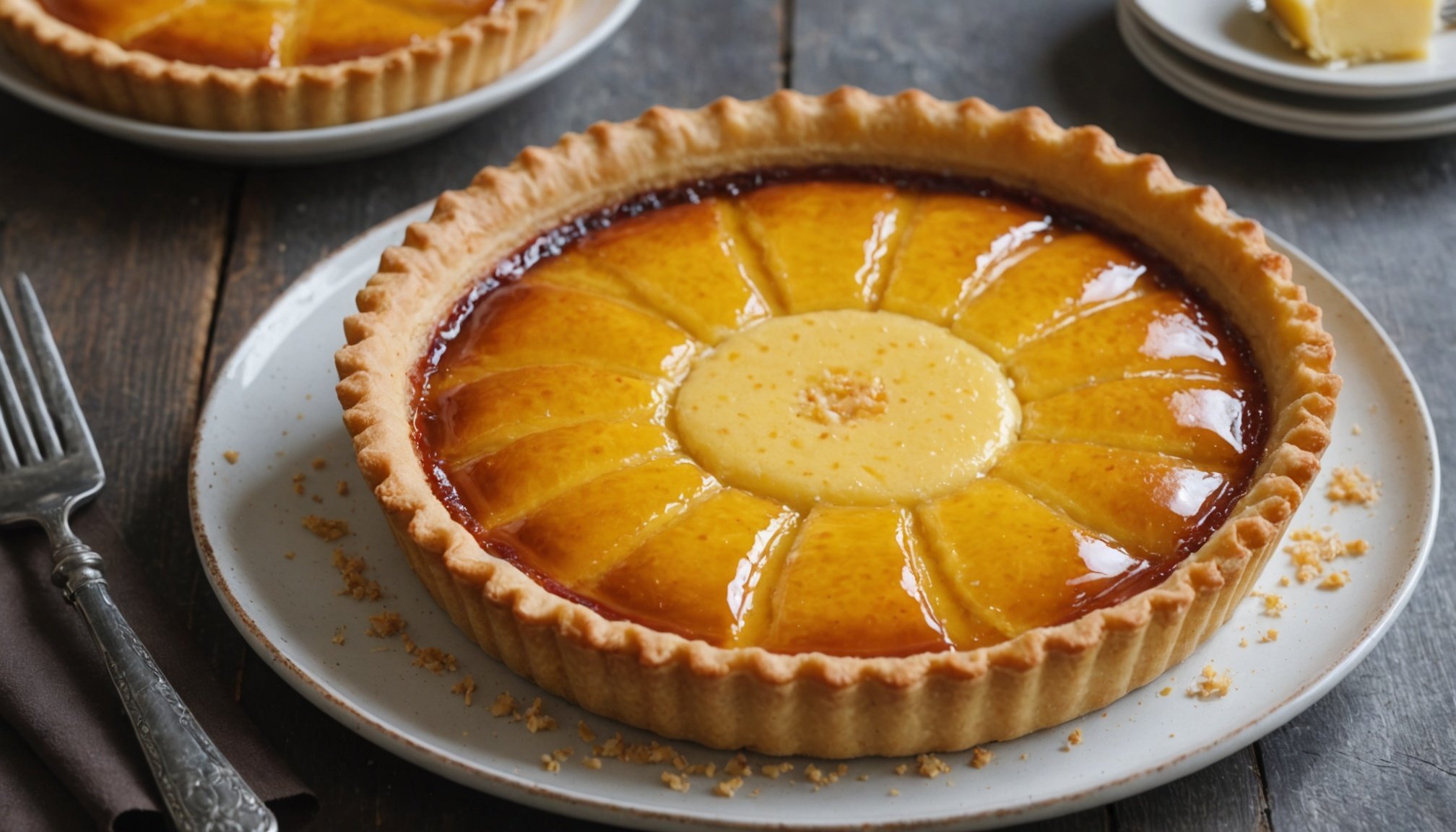Overview of English Custard Tarts
English custard tarts evoke images of traditional British baking, brimming with historical and cultural significance. Originating in the Middle Ages, these tarts were initially exclusive to royal feasts and high society gatherings. Traditional English custard tarts are characterised by their crisp pastry shells, filled with a rich and silky custard, flavoured subtly with vanilla or nutmeg. The delicate balance between a smooth custard and a perfectly baked crust defines these tarts.
Beyond their traditional form, custard tarts have inspired numerous regional variations. For instance, Portuguese Pastéis de Nata and French Clafoutis share similarities in set custards but diverge in flavouring and textural components. These regional variations offer a delightful spin on the classic tart, showcasing the adaptability of custard fillings across different cultures.
Also to discover : Unlock the Secrets to the Perfect English Pimm’s Cup: Expert Tips for Crafting the Ultimate Refreshing Beverage
Tart fillings also vary widely, from the traditional vanilla and nutmeg to citrus-infused custards and even savoury versions incorporating cheese or meats. Such diversity within custard tart fillings allows them to evolve continually while still preserving their English roots. Understanding the history and variations of these tarts enriches one’s appreciation of their culinary artistry, an enduring legacy in the world of confections.
Ingredients and Measurements
To perfect English custard tarts, choosing the right custard tart ingredients is crucial. Start with fresh, high-quality ingredients to achieve the best flavour. For the pastry crust, gather 200g of all-purpose flour, 100g of cold unsalted butter, 2 tablespoons of cold water, and a pinch of salt. These components create a crispy, buttery base that enhances the custard filling.
Also read : Master the Art of Fluffy Yorkshire Puddings with Flavorful Pan Drippings: An Expert Guide
For the custard filling itself, you’ll need 300ml of whole milk, 2 large eggs, 1 egg yolk, 50g of caster sugar, and a teaspoon of vanilla extract. Each of these measurements for custard is precise to ensure a silky, smooth texture. Using whole milk and fresh eggs guarantees creaminess and richness.
It’s also important to have the right baking supplies on hand. A 20cm tart tin, pastry brush, and sieve are essential for crafting professional-quality tarts. For accuracy in baking, consider investing in a kitchen scale for precise weight conversions, especially when following traditional recipes. Conversions play a vital role in replicating the authentic taste of English custard tarts, allowing bakers anywhere to enjoy this classic delight.
Preparation Techniques
Crafting English custard tarts requires precision and attention to detail in preparation. Begin with the pastry crust, an essential base for the tart. To form it, combine all-purpose flour with unsalted butter, using fingertips to achieve a breadcrumb-like consistency. Incorporate cold water slowly until the mixture forms a dough. Chill this dough, wrapped in cling film, for at least 30 minutes to ensure a crisp texture when baked.
In the realm of creating the custard filling, the technique is critical. First, gently heat whole milk while whisking together eggs, an egg yolk, and caster sugar. Ensure a smooth blend before slowly incorporating the warmed milk. This gradual combination prevents the eggs from scrambling, a key step in preparing a velvety custard.
This process may present common challenges, such as a lumpy texture or overcooked custard. Combat these issues by stirring continuously and maintaining a consistent heat. A low and steady temperature is crucial. Strain the mixture through a sieve to remove any lumps, achieving the desired silky consistency.
Mastering these baking techniques enhances the quality of custard tarts, ensuring a flawless fusion of crust and creamy custard. Through practice, refining these skills becomes an enjoyable and rewarding culinary endeavor.
Baking Process
To achieve perfect English custard tarts, the baking process demands attention to detail. Start by preheating your oven to 180°C (350°F), the ideal environment for balanced cooking. The key is ensuring an even bake, allowing the crust to develop a crisp exterior while the custard remains silky.
Place the prepared tart in the preheated oven and bake for around 25-30 minutes. This duration allows the custard to set beautifully without overcooking. Keep a close eye during the final minutes, as baking durations might vary slightly based on your oven’s calibration. Look for a slight jiggle in the centre of the custard; it’s an indicator of the perfect custard consistency, soft yet stable.
Observe the crust’s edges—they should be a golden-brown hue, signalling doneness. If your oven heats unevenly, consider rotating the tart halfway through the baking duration. This ensures that both the custard and the pastry crust achieve uniform doneness. A successful bake will exude a tempting aroma and feature a luscious creamy filling enveloped by a golden crust. These oven settings and how to bake custard tarts ensure a flawless dessert every time.
Achieving the Perfect Texture and Flavour
Creating the ideal custard tart texture involves a blend of custard consistency and flavour enhancement. To achieve a velvety custard, maintaining a low, consistent heat during cooking is crucial. Stir the mixture continuously to prevent lumps and achieve uniformity. A silky custard becomes the perfect partner for the crisp tart shell.
Flavour enhancement can be as simple as incorporating a dash of nutmeg or citrus zest, which adds depth beyond the classic vanilla. These additions should complement rather than overpower the custard’s natural creaminess. Experimenting with subtle spices like cardamom or cinnamon can further elevate the taste, offering a unique twist on the traditional dessert.
While striving for the perfect custard, common texture issues may arise, such as graininess or separation. These can be avoided by ensuring all ingredients are at room temperature before mixing. Strain the custard through a fine sieve if lumps form, restoring its smoothness.
Successful execution of these techniques will ensure not only a visually appealing tart but also one with enhanced flavour and texture, delighting anyone who takes a bite. These carefully considered steps ensure a dessert that’s as much a feast for the taste buds as for the eyes.
Common Mistakes and How to Avoid Them
In the quest to craft impeccable English custard tarts, understanding and avoiding common baking mistakes is paramount. One frequent error is overbaking, which can result in a rubbery texture instead of the desired creamy custard consistency. To counter this, monitor the tart closely during the final baking stages, watching for a gentle jiggle at the centre.
Another pitfall in custard tart troubleshooting is curdled or scrambled custard. This often occurs when adding the milk too quickly or using high heat. Always incorporate milk gradually while maintaining a low, consistent temperature to prevent these mishaps.
Issues with the pastry crust, like a soggy bottom, stem from under-baking the base before adding the filling. To perfect this, consider “blind baking” the pastry. This involves baking the crust initially without the filling, protecting it from becoming mushy once the custard is added.
Finally, achieving the ideal custard tart requires precision and patience. Constant adjustment and learning from cooking tips and mistakes ensures progress. Regular reflection on errors supports continuous improvement, leading to refined techniques and ultimately, flawless custard tarts. Embrace these solutions to enhance your baking skills and avoid potential pitfalls in future culinary endeavours.
Serving Suggestions and Variations
When serving custard tarts, presentation and temperature can enhance the dining experience. Traditionally, these tarts can be enjoyed either warm or chilled, each offering a unique texture and flavour profile. Serving them slightly warm accentuates the custard’s creaminess, while chilling provides a firm, refreshing finish.
Custard tart presentation is key to making this dessert visually appealing. A light dusting of powdered sugar or a sprinkle of nutmeg creates a classic look. For a modern twist, consider garnishing with fresh berries or a dollop of whipped cream. To achieve a vibrant presentation, edible flowers or citrus zest can add both colour and a hint of complementary flavour.
Exploring custard tart variations allows for culinary creativity. Popular variations include adding seasonal fruits like raspberries or a caramel topping, introducing exciting new dimensions to the traditional recipe. For a more indulgent version, integrate chocolate or espresso flavours into the custard, offering richness to the tart’s taste profile. Variations inspired by diverse cultures highlight the versatility of custard tarts, making them adaptable for various occasions and preferences.





